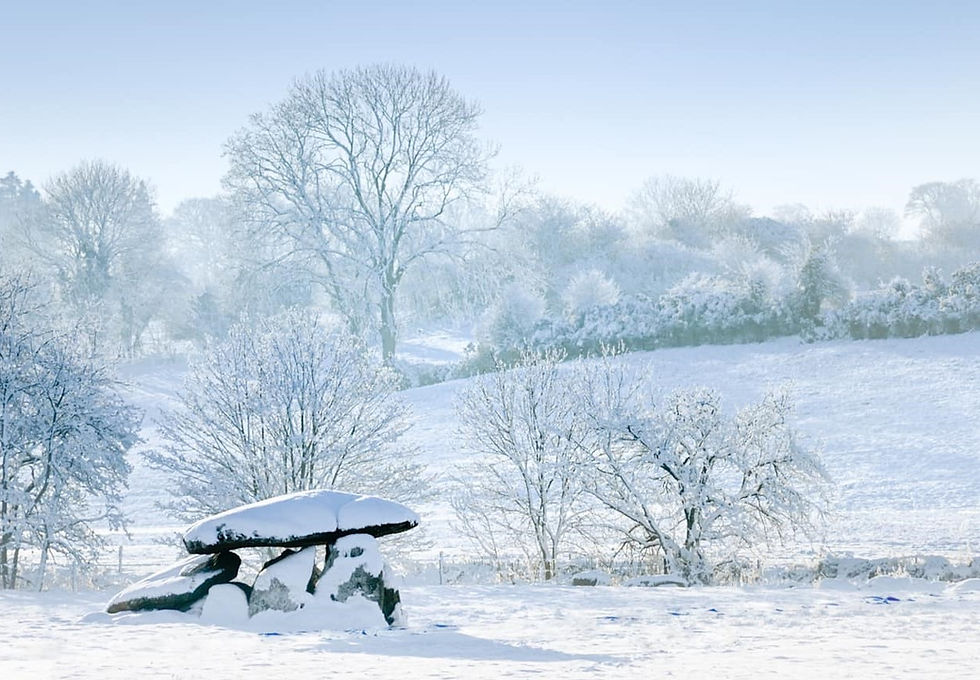Bealtaine, Fairies, and the Pleiades
- The heART of Ritual

- Apr 30, 2022
- 3 min read

In a previous post I wrote about the connection between our concepts of the similar patterns which appear throughout the universe, including microscopic organisms, and entire galaxies and constellations.
When it comes to star constellations and Bealtaine, you might be surprised at how strong the links are between the two.
In fact, within some ancient traditions it is not the date of May 1st which determines the date of Bealtaine at all. (Bear in mind that the time we know as Bealtaine was observed long before this title was given to it.)
Instead, this would be determined by the position of the Pleiades in conjunction with the sun.
The Pleiades were frequently called The Stróilin here in Ireland and people often timed their journeys by the position of these stars. "The Pleiades are frequently known as The Stróilín, and neighbours, when visiting, or on a Céilidhe, time their departure by the position of this constellation. If the Pleiades are setting they will say "It is late, The Stróilin is going down!" (Source)
The Pleiades movement into the constellation of Taurus may also have connecting significance to the celebration of cows at this time. The Dowth megalith, named ‘Stone of the Seven Suns’ by Martin Brennan, has been suggested to portray the Pleiades by Anthony Murphy of Mythical Ireland and the researcher Richard Moore. Anthony has also drawn attention to the Dowth legend relating to the king, Bresail Bó-Dibad (lacking in cattle), at the time of a great cattle famine in ancient times which left one bull and seven cows remaining in Ireland. This would seem to be a reference to Taurus and the seven 'sisters' of the Pleiades and back up that idea.
The motif of the cow is also one which is associated with Bealtaine. In ancient Ireland herds of cattle were said to be ritually driven between two huge fires at Bealtaine in order to protect and purify them.
In the Fertile Crescent and Egypt, Taurus was identified with Hathor and various cow goddesses.
Hathor represented both nourishment and beauty. For Romans, Taurus was said to be ruled by Venus, who was also the Goddess of beauty, and the Greeks equated Hathor with the goddess Aphrodite.
The month of May is named in honour of the Goddess Maia, also identified as the most beautiful of the Seven Sisters of the Pleiades. So, again, this stellar association makes itself known in astrological lore as well as mythological and historical correspondences. For some scholars Maia is analogous to the Irish Queen Maeve, the fairy Queen, but more about that in the next post in this short series.
The link to beauty and the Pleiades might be behind one particular old Irish custom of Bealtaine and Mayday. This entailed going outside just before sunrise and washing your face with the morning dew which was said to have been infused with the magic and power of the starlight.
But for all of the folklore, do we actually have evidence of the Pleiades being of ritual significance in ancient Ireland? Thanks to recent excavations we do. In his book, Harvesting the Stars: a pagan temple at Lismullin, Co. Meath, author Aidan O’Connell documents the recent discovery of the Pleiades alignment in the Gabhra Valley, beneath the Hill of Tara, Co. Meath. As we continue to discover further alignments thanks to the portable nature of new technology and star-plotting apps, the significance of Bealtaine in a stellar context may become more apparent.
The Pleiades cluster also features in many folklore anecdotes and myths relating to the dead and passing into and from the spirit world. In some traditions this middle place, or Otherworld, is the realm between the human world and the abode of the gods. It is a place where imagination, archetypes and the spirits all reside. You can understand why, for many, there is an overlap between fairies and the dead in this context.
Indeed, the connection between Bealtaine, fairies, and the Pleiades is represented in some very interesting lore. For some, Bealtaine is a time when 'bad' fairies roam and when people should be careful about boasting or flaunting their wealth. Others associate the rising of The Pleiades with the banishing of 'dark fairies' until Samhain, when the Pleiades instead rise at sunset. Perhaps the appearance of the Pleiades in the night sky at sunset, as opposed to sunrise, accounts for this switch?
Irish folklore doesn't really have a category of 'good' or 'bad' fairies, though, so this may be a more recent development. Or maybe the truth of this belief lies somewhere in-between and it is our own nature which determines the type of interaction we have with ‘the good people’ should we encounter them! (C.) David Halpin.


